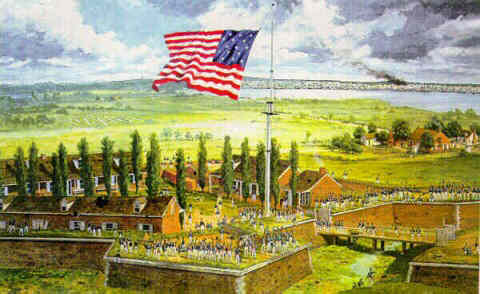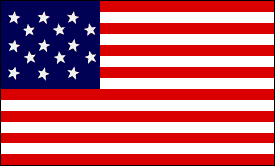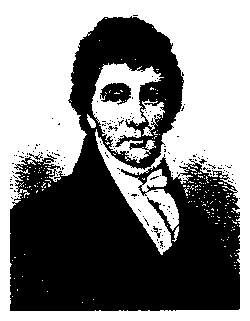



While making preparations for the The Battle of Baltimore,
Major George Armistead requested a flag to be
"so large that the British will have no difficulty in seeing it from a distance"
to be flown over the Fort.
Mary Pickersgill of Baltimore was commissioned to construct the flag.
With help from her daughter Caroline, she sewed a woolen flag measuring
42 feet long by 30 feet high, a remarkably large flag.

The flag has fifteen stars and fifteen stripes.
During the War of 1812 there were 15 states in the Union,
Vermont and Kentucky having been added to the original 13.
An early plan for the flag was to add a new star and a new
stripe for each new state.
With 15 stripes on the Pickersgill flag which was 30 feet high,
that meant that each stripe was 2 feet wide.
On that flag each star was also 2 feet across

"Fort McHenry"
This late 18th century star-shaped fort is world famous as the
birthplace of the American national anthem. The guardian of
Baltimore's harbor, it was the valiant defense of Fort McHenry by
American forces during a British attack on 13 - 14 September 1814,
that inspired 35 year old, poet-lawyer Francis Scott Key to write
"The Star-Spangled Banner."
Following the Battle of Baltimore during the War of 1812, the Fort never
again came under attack. However, it remained an active military post
off and on for the next 100 years.
During the Civil War, it was occupied by Union forces who used it as a
prison camp for the detention of Confederate soldiers,
southern sympathizers, and political prisoners.
From 1917 until 1923, U.S. Army General Hospital No. 2 was located
at the Fort to serve World War I troops.
A portion of the 43 acre park was used as a U.S. Coast Guard training
facility as late as World War II.
It became an area administered by the National Park Service in 1933,
two years after Key's poem became this country's national anthem.
Of the approximately 370 areas in the National Park System,
Fort McHenry is the only one designated both a
National Monument and Historic Shrine.
"Fort McHenry - Facts"
Here are some facts pertaining to:
Star Fort Construction,
The Battle of Baltimore,
The Civil War
STAR FORT CONSTRUCTION
Name of Designer: Jean Foncin - French
Date construction started 1799
Completion Masonry Walls and Buildings Completed: 1805
Square footage of fort:
Civil War Powder Magazine: 11,512 square feet
Civil War Powder Magazine Perimeter Wall: 15,192 square feet
Star Fort Exterior Walls: 22,261 square feet
Number of Rooms:
Star Fort: 30 - includes bombproofs
Civil War Powder Magazine: 2
Outer Battery - underground chambers: 4
Height of Exterior Walls: 15 Feet
Length of Seawall: 12,500 feet
Height of Flagpole Above Ground: 89 Feet
BATTLE OF BALTIMORE
Data on Fort McHenry:
Commander: Major George Armistead - Later promoted to Lt. Colonel
Defenders of Fort McHenry:
U.S. Corps of Artillery - Capt. Frederick Evans - One Company, 80 Men
U.S. Sea Fencibles - Capt. M.S. Bunbury & and Wm. H. Addison
Two Companies, 200 Men
U.S. Chesapeake Flotilla - Sailing Master Solomon Rodman, 60 Men
U.S. Infantry - Lt. Colonel Wm. Stewart - Two companies of the 36th,
four Companies of the 38th, one Company of the 12th, 600 Men
Md. Vol. Militia Artillery, 180 men
Baltimore Fencibles, Capt. J. H. Nicholson
Baltimore Independent Arterialist, Lt. C. Pennington
Washington Artillery, Capt. John Berry
CIVIL WAR
Number of Confederate Prisoners of War: Approx. 15,000
Number of Confederate Prisoners from Gettysburg: Approx. 7,000
Commander of Fort McHenry:
Brigadier General William Morris, 2nd U.S. Artillery
Number of Executions at Fort: 1 Hanging, Two Firing Squads.
Regiments Stationed at Fort:
2nd U.S. Artillery
11th Indiana Veteran Volunteers
192nd Pa. Volunteer Infantry
7th New York Artillery
8th New York Artillery
1st Connecticut Heavy Artillery
Number of Guns Mounted: 72



1779 - 1843
Then, in that hour of deliverance, my heart spoke
"Does not such a country, and such defenders of their country, deserve a song"
Francis Scott Key
Francis Scott Key, son of an established Maryland family,
was born on August 1, 1779, in Frederick, Maryland
on the family estate of "Terra Rubra"
He attended grammar school and later graduated from
St. Johns College in Annapolis at age 17.
By 1805, Key had established a law practice in Georgetown, Maryland,
and by 1814, had appeared many times before the U.S. Supreme Court.
The site of his house on M Street is now a memorial park.
Key was a religious man and was involved in the Episcopal church.
Although opposed to the war, he served for a brief period in the
Georgetown Light Field Artillery, 1813 -1814.
During the Battle of Bladensburg, Key assigned field positions to
American troops, a duty he had no expertise in.
Francis Scott Key was a respected young lawyer living in Georgetown
just west of where the modern day Key Bridge crosses the Potomac River,
the house was torn down after years of neglect in 1947.
He made his home there from 1804 to around 1833 with his wife Mary
and their six sons and five daughters.
At the time, Georgetown was a thriving town of 5,000 people
just a few miles from the Capitol, the White House,
and the Federal buildings of Washington.
But, after war broke out in 1812 over Britian's attempts to regulate
American shipping and other activities while Britain was at war with
France, all was not tranquil in Georgetown.
The British had entered Chesapeake Bay on 19 August 1814,
and by the evening of the 24th of August, the British had invaded
and captured Washington.
They set fire to the Capitol and the White House,
the flames visible 40 miles away in Baltimore.
President James Madison, his wife Dolley, and his Cabinet had
already fled to a safer location.
Such was their haste to leave that they had had to rip the Stuart
portrait of George Washington from the walls without its frame.
A thunderstorm at dawn kept the fires from spreading.
The next day more buildings were burned, and again a thunderstorm
dampened the fires.
Having done their work the British troops returned to their ships in
and around the Chesapeake Bay.
In the days following the attack on Washington, the American forces
prepared for the assault on Baltimore, population 40,000, that they
knew would come by both land and sea.
Word soon reached Francis Scott Key that the British had carried
off an elderly and much loved town physician of Upper Marlboro,
Dr. William Beanes, and was being held on the British flagship Tonnant.
The townsfolk feared that Dr. Beanes would be hanged.
They asked Francis Scott Key for his help, and he agreed,
and arranged to have Col. John Skinner, an American agent for
prisoner exchange to accompany him.
The morning of September 3rd, he and Col. Skinner set sail from Baltimore
aboard a sloop flying a flag of truce approved by President Madison.
On the 7th they found and boarded the Tonnant to confer with
General Ross and Admiral Alexander Cochrane.
At first they refused to release Dr. Beanes, but Key and Skinner
produced a pouch of letters written by wounded British prisoners,
praising the care they were receiving from the Americans, among them
the care of Dr. Beanes.
The British officers relented but would not release the three Americans
immediately because they had seen and heard too much of the preparations
for the attack on Baltimore.
They were placed under guard, first aboard the H.M.S. Surprise, then onto the
sloop and forced to wait out the battle behind the British fleet.
Now let's go back to the summer of 1813 for a moment.
At the star-shaped Fort McHenry, the Commander, Major George Armistead
asked for a flag so big that
"the British would have no trouble seeing it from a distance".
Two officers, a Commodore and a General, were sent to the Baltimore home
of Mary Young Pickersgill, a "maker of colours," and commisioned the flag.
Mary and her thirteen year old daughter Caroline, working in an upstairs
front bedroom, used 400 yards of best quality wool bunting.
They cut 15 stars that measured two feet from point to point.
Eight red and seven white stripes, each two feet wide, were cut.
Laying out the material on the malthouse floor of Claggett's Brewery,
a neighborhood establishment, the flag was sewn together.
By August it was finished, it measured 30 by 42 feet and cost $405.90.
At 7 a.m. on the morning of September 13, 1814,
the British bombardment began, and the flag was ready to meet the enemy.
The bombardment continued for 25 hours, the British firing 1,500 bombshells
that weighed as much as 220 pounds and carried lighted fuses that would
supposedly cause it to explode when it reached its target.
But they weren't very dependable and often blew up in mid air.
From special small boats the British fired the new Congreve rockets that
traced wobbly arcs of red flame across the sky.
The Americans had sunk 22 vessels so a close approach by the British
was not possible.
That evening the connonading stopped, but at about 1 a.m. on the 14th,
the British fleet roared to life, lighting the rainy night sky with grotesque
fireworks.
Key, Col. Skinner, and Dr. Beanes watched the battle with apprehension.
They knew that as long as the shelling continued, Fort McHenry had not
given up and surrendered.
But, long before daylight there came a sudden and mysterious silence.
What the three Americans did not know was that the British land assault
on Baltimore as well as the naval attack, had been abandoned.
Judging Baltimore as being too costly a prize, the British officers ordered a retreat.
Waiting in the predawn darkness, Key waited for the sight that would end
his anxiety, the joyous sight of Gen. Armisteads great flag blowing in the breeze.
When at last daylight came, the flag was still there.
Being an amatuer poet and having been so uniquely inspired,
Key began to write on the back of a letter he had in his pocket.
Sailing back to Baltimore he composed more lines and in his lodgings at the
Indian Queen Hotel he finished the poem.
Judge J. H. Nicholson, his brother-in-law, took it to a printer and copies
were circulated around Baltimore under the title "Defence of Fort M'Henry".
Two of these copies survive.
It was printed in a newspaper for the first time in the Baltimore Patriot on
20 September 1814, then in papers as far away as Georgia and New Hampshire.
To the verses was added a note "Tune - Anacreon in Heaven"
In October a Baltimore actor sang Key's new song in a public performance
and called it:
"The Star-Spangled Banner"
Immediately popular, it remained just one of several patriotic airs until
finally adopted as our National Anthem on 3 March 1931.
But the actual words were not included in the legal documents.
Key himself had written several versions with slight variations so
discrepancies in the exact wording still occur.
The flag, our beloved Star-Spangled Banner, went on view ,
for the first time after flying over Fort McHenry, on 1 January 1876 at the
Old State House in Philadelphia for the nations' Centennial celebration.
It now resides in the Smithsonian Institution's Museum of American History.
An opaque curtain shields the now fragile flag from light and dust.
The flag is exposed for viewing for a few moments once every hour
during museum hours.
Francis Scott Key was a witness to the last enemy fire to fall on Fort McHenry.
The Fort was designed by a Frenchman named Jean Foncin, and was named
for then Secretary of war James McHenry. Fort McHenry holds the unique
designation of national monument and historic shrine.
Since 30 May 1949, the flag has flown continuously,
by a Joint Resolution of Congress, over the monument marking the site of
Francis Scott Key's birthplace, Terra Rubra Farm, Carroll County, Keymar, Maryland.
The copy that Key wrote in his hotel September 14,1814, remained in the
Nicholson family for 93 years.
In 1907 it was sold to Henry Walters of Baltimore.
In 1934 it was bought at auction in New York from the Walters estate by the
Walters Art Gallery, Baltimore for $26,400.
The Walters Gallery in 1953 sold the manuscript to the Maryland Historical Society
for the same price.
Another copy that Key made is in the Library of Congress.
Key was the brother-in-law of Roger Brooke Taney who served as Chief Justice
and administered the oath of office to Abraham Lincoln in 1861.


National Anthem of the United States of America
Music attributed to John Stafford Smith
Words by Francis Scott Key
Program Note:
The Star Spangled Banner was born out of the emotions experienced
by Francis Scott Key as he watched the bombardment of Fort McHenry
during the War of 1812.
Key's poem, "Defense of Fort McHenry," came to be sung to the tune
of a pre-existing popular English drinking song,
"To Anacreon in Heaven", the melody of which is attributed to
Englishman John Stafford Smith.
The first musical edition was published by Benjamin Carr of Baltimore
and titled "The Star-Spangled Banner."
With the passage of time the song grew in popularity, and in 1931 an act of
Congress made it our official national anthem.
First Verse
Oh, say, can you see, by the dawn's early light,
What so proudly we hail'd at the twilight's last gleaming?
Whose broad stripes and bright stars, thro' the perilous fight,
O'er the ramparts we watch'd, were so gallantly streaming?
And the rocket's red glare, the bombs bursting in air
Gave proof thro' the night that our flag was still there.
Oh, say, does that Star-Spangled Banner yet wave
O'er the land of the free and the home of the brave
Second Verse
On the shore, dimly seen thro' the mists of the deep,
Where the foe's haughty host in dread silence reposes,
What is that which the breeze, o'er the towering steep,
As it fitfully blows half conceals, half discloses?
Now it catches the gleam of the morning's first beam,
In full glory reflected now shines in the stream;
'Tis the Star-Spangled Banner, O long may it wave
O'er the land of the free and the home of the brave
Third Verse
Oh, thus be it ever when free men shall stand
Between their loved homes and the war's desolation!
Blest with vict'ry and peace, may the heav'n rescued land
Praise the Pow'r that hath made and preserved us a nation!
Then conquer we must, when our cause it is just,
And this be our motto, "In God is our trust"
And the Star-Spangled Banner in triumph shall wave
O'er the land of the free and the home of the brave

Click Image Below To
Return To The Site Options







"Does not such a country, and such defenders of their country, deserve a song"
Francis Scott Key

Music attributed to John Stafford Smith
Words by Francis Scott Key
Click Image Below To
Return To The Site Options
